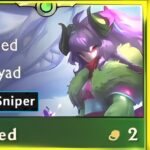Introduction:
Teamfight Tactics (TFT) is a game of strategy and choices. One of the most debated decisions is Kindred’s color. Red or blue Kindred? It’s a question that haunts TFT players. This guide will unravel the mystery behind this crucial choice. We’ll explore the strengths and weaknesses of each option. You’ll learn when to choose red and when blue is best. By the end, you’ll be equipped to make the right call. Let’s dive into the world of Kindred and dominate your TFT matches!
Understanding Kindred in TFT
Before we tackle the color debate, let’s review Kindred’s basics:
• Kindred is a 4-cost unit in TFT
• They belong to the Eternal and Spirit Hunter traits
• Their ability, Lamb’s Respite, creates a protective zone
• Kindred’s power can turn the tide of battle
Knowing these fundamentals is crucial for making the right color choice.
The Red Kindred: Aggressive Power
Red Kindred is all about offense. Here’s what you need to know:
• Red boosts Kindred’s attack damage
• It enhances their ability to take down enemies quickly
• Red Kindred excels in aggressive team compositions
• They’re particularly effective in the early and mid-game
Red Kindred can dominate matches when used correctly.
Advantages of Red Kindred:
1. Higher burst damage potential
2. Stronger early game presence
3. Synergizes well with attack damage items
4. Can snowball leads effectively
5. Performs well in assassin-heavy metas
These benefits make Red Kindred a popular choice among players.
Disadvantages of Red Kindred:
• Less effective in longer fights
• Vulnerable to crowd control
• May struggle against tanky compositions
• Requires careful positioning to maximize damage output
Consider these drawbacks when opting for Red Kindred.
The Blue Kindred: Defensive Mastery
Blue Kindred takes a different approach. Let’s examine their strengths:
• Blue enhances Kindred’s ability power
• It improves the effectiveness of Lamb’s Respite
• Blue Kindred shines in defensive and control-oriented teams
• They excel in the late game and extended fights
Blue Kindred can be a game-changer in the right situations.
Advantages of Blue Kindred:
1. Stronger protective ability
2. Better scaling into late game
3. Synergizes well with ability power items
4. Provides more utility to the team
5. Excels in mage-heavy compositions
These factors make Blue Kindred a formidable option.
Disadvantages of Blue Kindred:
• Lower direct damage output
• May struggle in early skirmishes
• Requires team support to reach full potential
• Less effective against burst damage compositions
Keep these limitations in mind when choosing Blue Kindred.
Factors Influencing Your Choice
Several elements should guide your Kindred color decision:
1. Your team composition
2. Enemy team composition
3. Current stage of the game
4. Available items and resources
5. Your preferred playstyle
6. The meta of your rank or lobby
Consider all these factors for the best results.
Red Kindred: Ideal Scenarios
Red Kindred thrives in certain situations:
• When you need early game dominance
• In assassin-heavy team compositions
• Against squishy enemy teams
• When you have strong AD items
• In fast-paced, aggressive metas
Recognize these scenarios to make the most of Red Kindred.
Blue Kindred: When to Choose
Blue Kindred shines in different circumstances:
• In late-game focused strategies
• With mage or control-oriented teams
• Against burst damage compositions
• When you have strong AP items
• In slower, more defensive metas
Identifying these situations will help you utilize Blue Kindred effectively.
Item Synergies for Red Kindred
Equip Red Kindred with the right items:
• Infinity Edge for critical strike damage
• Bloodthirster for sustain
• Last Whisper against armor-heavy teams
• Rapid Firecannon for range and attack speed
• Giant Slayer for tank-busting potential
These items amplify Red Kindred’s strengths.
Item Synergies for Blue Kindred
Blue Kindred benefits from different itemization:
• Jeweled Gauntlet for spell critical strikes
• Blue Buff for faster casting
• Archangel’s Staff for scaling power
• Morellonomicon for anti-healing
• Ionic Spark for additional magic damage
These items enhance Blue Kindred’s protective and damage potential.
Team Compositions for Red Kindred
Red Kindred excels in these team builds:
• Assassin-heavy comps for burst potential
• AD-focused teams with strong frontlines
• Fast-paced, aggressive strategies
• Compositions that aim to end games early
Build your team around Red Kindred’s strengths for maximum impact.
Team Compositions for Blue Kindred
Blue Kindred shines in these team setups:
• Mage-centric compositions for ability synergy
• Control-oriented teams with multiple CC units
• Late-game scaling strategies
• Defensive comps that rely on sustain
Craft your team to complement Blue Kindred’s defensive prowess.
Adapting Mid-Game: Switching Colors
Sometimes, you need to pivot. Here’s when to consider switching:
• Your initial strategy isn’t working
• The enemy team composition changes dramatically
• You acquire items that better suit the other color
• The game pace shifts unexpectedly
Flexibility can be the key to victory.
Common Mistakes to Avoid
Watch out for these pitfalls:
• Sticking to one color regardless of the situation
• Neglecting to adapt your itemization
• Ignoring team synergies when choosing a color
• Underestimating the impact of Kindred’s color choice
Avoiding these errors will improve your TFT performance.
The Impact of TFT Patches
TFT is constantly evolving. Keep these points in mind:
• Patches can shift the meta dramatically
• Kindred’s effectiveness may change with updates
• Stay informed about the latest balance changes
• Be prepared to adjust your strategies accordingly
Staying up-to-date is crucial for consistent success.
Advanced Strategies: Hybrid Kindred
For the bold, there’s a third option:
• Hybrid builds combine elements of red and blue
• This approach offers flexibility but requires skill
• It can be powerful in the right hands
• Consider hybrid when facing diverse enemy comps
Mastering hybrid Kindred takes practice but can be rewarding.
The Psychology of Kindred Colors
Your color choice can affect your opponents:
• Red Kindred may intimidate aggressive players
• Blue Kindred might bait enemies into prolonged fights
• Your choice can influence enemy positioning and item builds
Use this psychological edge to your advantage.
Analyzing Pro Player Preferences
Learn from the best:
• Study how pro players use Kindred
• Notice trends in high-elo matches
• Understand the reasoning behind their color choices
• Adapt pro strategies to your own playstyle
Pro insights can elevate your Kindred game.
Future of Kindred in TFT
Looking ahead, consider these possibilities:
• New traits or mechanics affecting Kindred’s role
• Potential reworks or significant changes to the champion
• Evolving metas that may favor one color over time
Stay adaptable to remain competitive in future TFT seasons.
Conclusion:
Mastering kindred red or blue tft is a journey of strategy and adaptation. The choice between red and blue isn’t just about color. It’s about understanding the game’s nuances. Red offers aggressive power, while blue provides defensive utility. Your decision should be based on team composition, items, and the current meta. Remember, flexibility is key. Don’t be afraid to switch colors mid-game if needed. Practice both styles to become a versatile player. With this knowledge, you’re now equipped to make informed decisions. So jump into your next TFT match and put your Kindred mastery to the test. May your choices lead you to victory!
FAQs:
1. Is one Kindred color objectively better than the other?
No, each color has its strengths depending on the situation.
2. Can I change Kindred’s color mid-game?
Yes, through careful itemization and planning.
3. How does Kindred’s color affect their ultimate ability?
Red enhances damage, while blue improves the protective aspect.
4. Are there specific items that work best for each color?
Yes, AD items for red and AP items for blue.
5. Does Kindred’s color choice impact their trait synergies?
No, traits remain the same regardless of color.
6. How often does the meta shift between favoring red or blue Kindred?
It varies with patches and player discoveries, usually every few weeks.
7. Can I play Kindred effectively without choosing a specific color?
It’s possible but generally less optimal than committing to a color.






